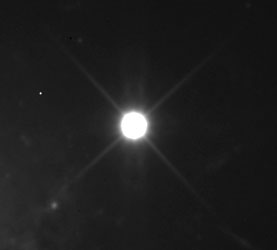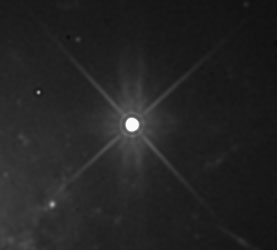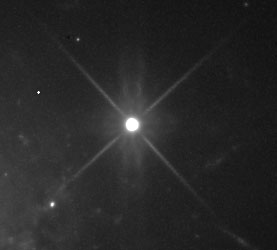







1. Raw
2. DDP Only
3. Deconvolution + DDP
4. DDP + Deconvolution
Deconvolution:A mathematical process for restoring astronomical images which have been degraded by atmospheric turbulence, telescope optics, mount instability, or tracking problems. In practice, deconvolution is applied by performing successive Fourier Transforms on an image. The parameters for the process are quite critical and have to be set accurately to achieve optimum results.
Problem: Although I started CCD imaging in February 2001 I had not succeeded in getting both deconvolution and DDP (Digital Development Process) to work successfully on an image. The result was always a very noisy image, to the extent that it became unusable. This had not been a major problem initially because I had not encountered a need to perform both Deconvolution and DDP on an image (either one of these had worked individually depending on the type of image).
However on 12th April 2002 I made a new image of M63 which was very soft owing to a particular type of atmospheric turbulence. FWHM measurements in individual images were not bad (2.2 arc seonds average). But there was a low frequency turbulence which caused large scale distortions between the images. When 8 images were combined the result was blurred. It was immediately clear that both deconvolution and DDP were needed. But what to do? - I had never succeeded in getting these to work together.
In the three weeks since this image was taken I experimented heavily with three deconvolution programs:
- CCDSharp
- Maxim's Maximum Entropy
- AIP's Deconvolution
The results are below. I show the result of three different processing sequences starting with the raw image on the left. In the raw image I have marked two gas emission regions which are particularly interesting - please watch carefully what happens to those regions in each of the steps. Also, because DDP can adversely affect star images, I have included a separate crop of a bright star above each of the respective galaxy images. Unfortunately I was unable to get a usable result from CCDSharp - despite much experimentation the result with this image always had excessive noise. I am grateful for the help from Douglas George in achieving the result from Max Entropy.
|
|
|
|
|
|
|
|
|
|
|
1. Raw |
2. DDP Only |
3. Deconvolution + DDP |
4. DDP + Deconvolution |
Process Summary
1. Raw
- Sum of 8 images - No DDP or Deconvolution
2. DDP Only
- MaximDL DDP; FFT 2.5% (medium) setting
3. Deconvolution + DDP
- MaximDL Max Entropy; PSF 1.5; 22 iterations
- Maxim DDP; FFT 5% (mild) setting
4. DDP + Deconvolution
- MaximDL DDP: FFT 5% (mild) setting
- AIP Deconvolution: Radius 2.5 : Richardson-Lucy : NR 1.0 : Iterations 5 : Process only high-frequency components
Observations
I do not present the above as in any way representative of the optimum results from the products concerned. These are only the results of my own experiments based on limited knowledge. The results quite possibly misrepresent the capabilities of MaximDL, for instance. Having said that this was the best I could achieve at the time after considerable time and effort with each of the products:
#1 The starting point. This image is provided as a comparison reference to the others. Do keep a close eye on what happens to the marked gas emission regions through the sequence.
#2 The expected result from DDP only. It starts to look like a galaxy but is still far from optimum.
#3 A marked improvement, especially in the region around the core. It may be that Max Entropy provides the best low frequency deconvolution in this comparison. It is hard to judge. Personally I do not like the reduction of the galaxy core to a small circle with a dark ring around it. I am sure that the galaxy core does not really look like that. The same comment applies to the star. Max Entropy was good at keeping the noise under control.
#4 This result was astonishing to me. It is based entirely on a process described briefly by Chris Schur:
"I do DDP to constrain the brighness range of the image, then use AIP RL deconvolution, HF components to do only 5 iterations. Thats enough to clean up the bloated stars DDP does, and then I bring it back into Maxim and apply the hot pixels filter to remove any noise brought out by the RL HF components process".
Look especially at the (left-most) tri-lobed gas emission region. This was the only process that revealed it clearly as tri-lobed. In fact zooming in on the original reveals it to have four lobes. Look at the other gas emission regions and note how clearly they are revealed in comparison with the other images. Note that the broader structures are well revealed and seem comparable with the Max Entropy result. Note that, despite the sharpening, the noise has been maintained at a low level. Finally, note the complete absence of dark perimeters and other artefacts around the sharpened objects. The same applies to the star which looks more natural than in any of the other images. #4 was something of a "breakthrough" for me.
|
|
|
|
Original Attempt: mild DDP only |
Final Attempt: DDP + Deconvolution in AIP |
|
|
|
|